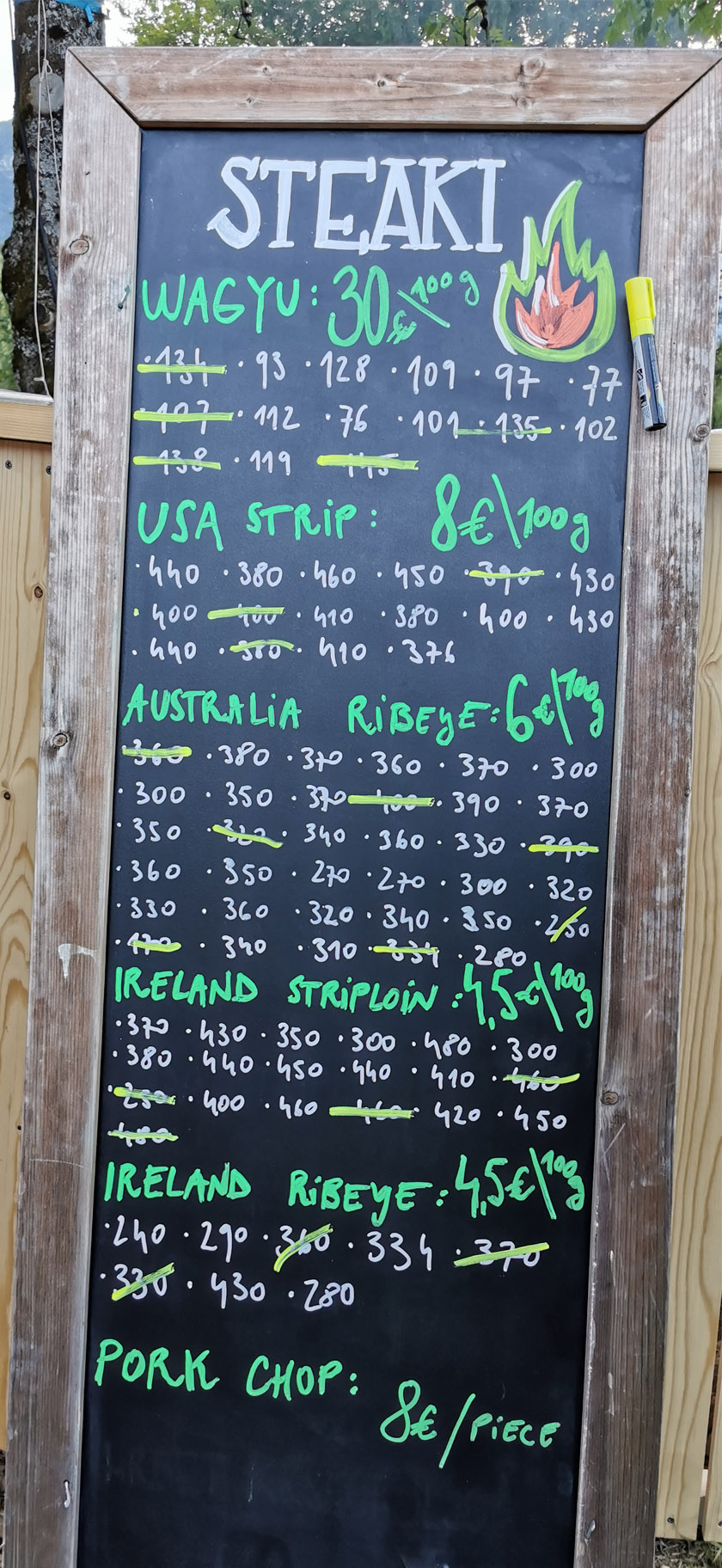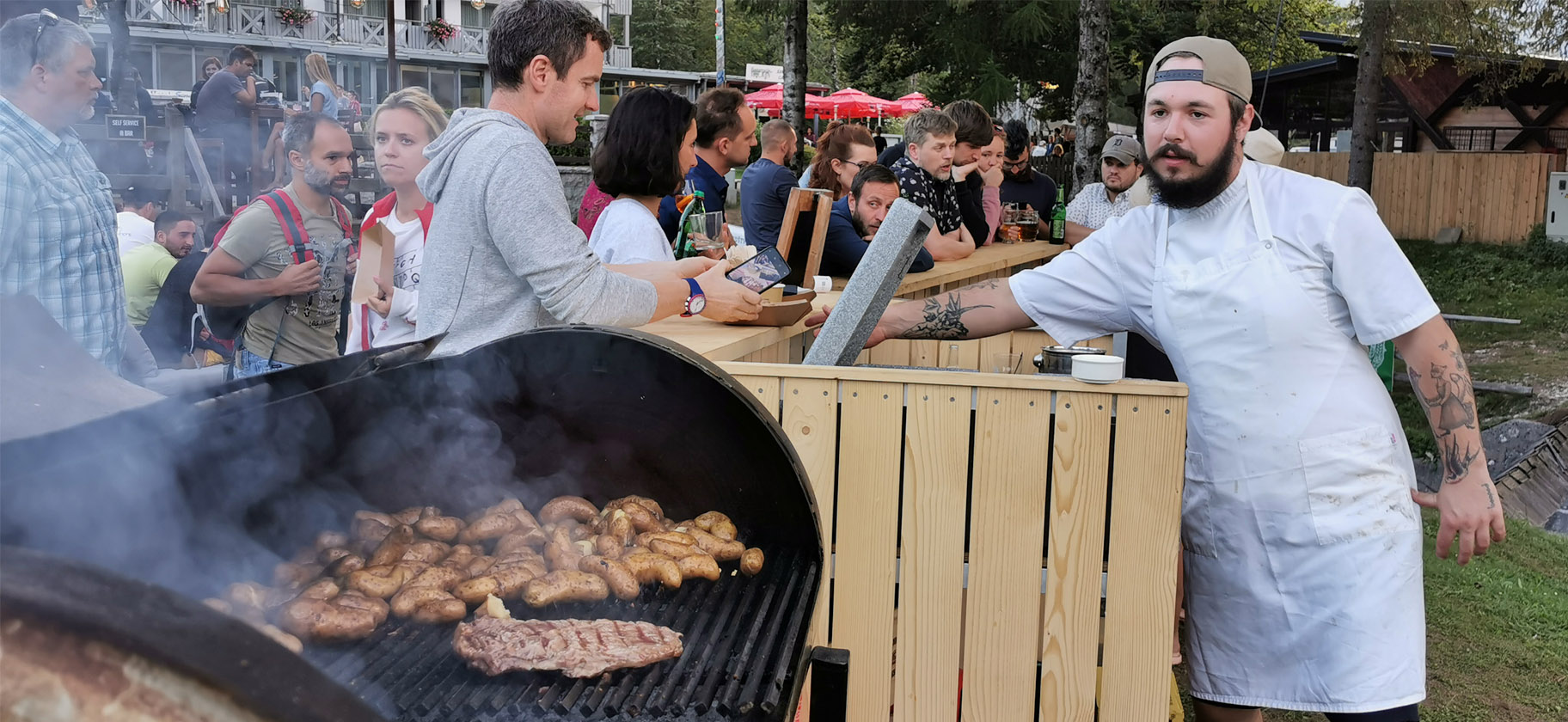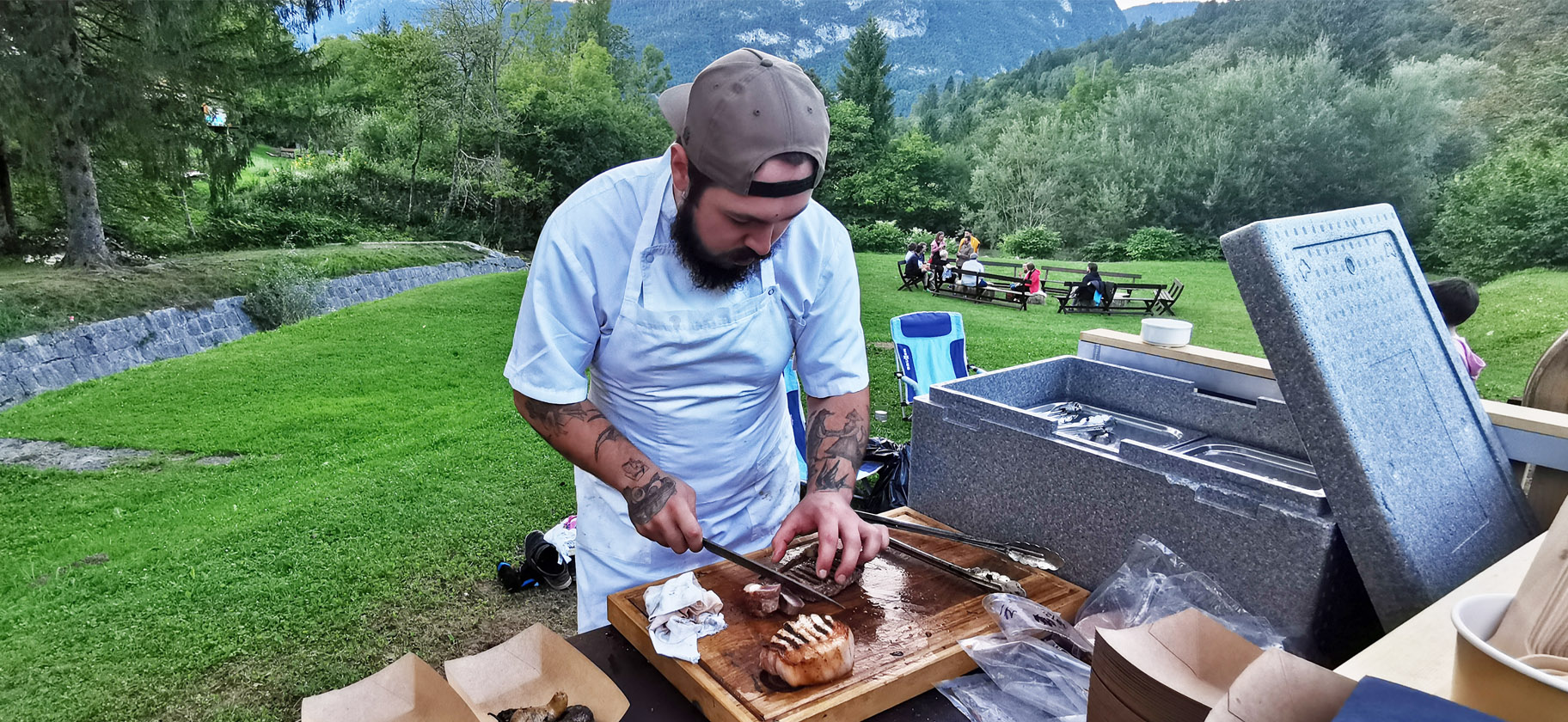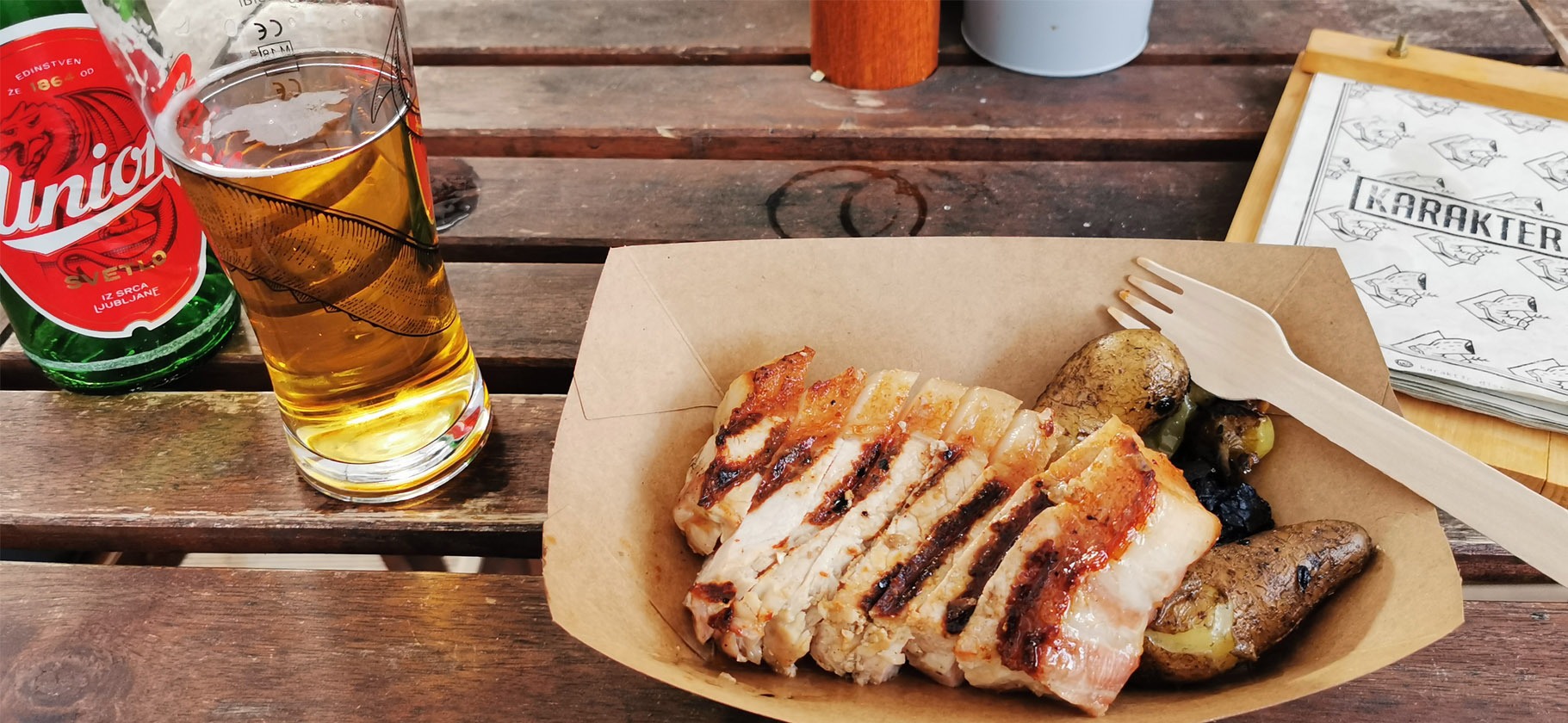Marco’s Meat Business Means Business

Seventy-five kilometres northwest of the capital, Ljubljana, tucked away in the Julian Alps lies an isolated little lake called Bohinj. Off the main route which runs through Kranj to Jesenice, Bohinj has managed to remain relatively unknown compared to its more renowned sister lake, Bled, just twenty kilometres away. Bohinj’s remoteness is part of its appeal and whereas Bled is regularly trodden underfoot by tourists who get carted in on crowded trains, Bohinj has managed to stay somewhat pristine and untouched. A still, calm, quiet lake in the shadow of mountains under an endless sky, the view from The Bridge that connects Ribcev Laz with Stara Fuzina is incomparably beautiful.
Because of the Feast of the Assumption, a national holiday in Slovenia, public transit was down to a minimum and by the time I arrived in Ribcev Laz it was already quite late. I was feeling pretty worn out from a day hiking in Bled, from working on my projects, from trains and hitchhiking. I was paying a lot for my hotel so I had had a mind to self-cater, but all that was about to change. I went off exploring the little village and walked past an open-air bar, called Karakter, that had a plume of smoke rising out the back. I travelled around behind the bar where there was a barbecue spit set up and, at first glance, I thought that some visitors were just having a cookout. There was a small wooden countertop out front and a sign that read, STEAKI, and had various numbers and descriptions of cuts of beef.
The word ‘wagyu’ piqued my interest and, when I went to inquire, a young man in sunglasses and a Panama hat and wearing a big smile was there to greet me.
 “You don’t really have wagyu beef, do you?” I asked.
“You don’t really have wagyu beef, do you?” I asked.
“I sure do,” he said.
“I thought that real wagyu was unobtainable outside of Japan?”
“Usually, yes. But I know a guy.”
“So how does he get even get it here?”
“No joke,” he says, “I get the guy to vacuum seal it and then we stuff the cuts into a suitcase. The trick is to get it all on just the right flight so we can take care of it so it can keep just the right amount of freshness and it won’t spoil.”
I was skeptical, but then he bent down under the counter and presented me with a vacuum-sealed, 100-gram, piece of perfectly marbled beef. It wasn’t proof, but it was convincing.
That was how I met Marco who runs a local company called Meat Business. Based in Ljubljana, on occasions such as today Marco and his team set up shop in towns across Slovenia and barbecue their cuts of beef with a side of potatoes and grilled veggies for anybody who might pass by and fancy some steak. All those numbers on the board were the weights of the various cuts in the cooler and one had only to choose their origin, cut, and weight. For example, you could order an Australian rib-eye at 300 grams which would cost you 18 euros – which is competitive against any restaurant in the area.
I had determined to self-cater and spending 20 euros on a meal seemed steep to me especially considering what I was already paying for my hotel. But seeing all of those cuts of meat on display on Marco’s counter and the interest it was drawing from passers-by had me second-guessing.
“Are you going to be back here tomorrow?” I asked.
“No, we definitely won’t be here tomorrow. Tomorrow’s up in the air,” Marco said with a wink. “If we do really well tonight we’ll go out drinking and then we might not set up shop at all, but otherwise we’ll be in Kranj tomorrow. But we should be back the day after that.”
Sticking around an extra day just to get some steak was just going to slow me down and I had calculated my route and it didn’t include an extended stay in Bohinj.
“And how long are you guys going to be around tonight?”
“Until it’s all gone.”
“I imagine you only take cash, don’t you?”
“No, we take credit cards.”


I was determined to self-cater, but Marco had deflected every possible objection. He had a winning smile, an entrepreneurial spirit, and he understood his meat. He could look into your eye and understand your motivation and find the right cut for you:
“You like your steak with a lot of flavour, don’t you?” he said, addressing a customer. When they nodded assent, he continued. “Listen, the Irish striploin is good but it has less fat because it’s completely grass-fed and finished. The Australian rib-eye, now that’s finished on grain and has more fat and more marbling. It’s not chewy or anything because it’s marbling which means it’s part of the meat, it’ll be good for you I think.”
Over at the grill was Time. Time had a serious look on his face like he was in the zone. He was constantly tossing potatoes and shifting meat from side to side with a constant stream of charcoal fumes blowing at him from the grill. Spry and swift for a big man he would shift to the carving table where the steaks would rest for a few minutes and then he would shift back again to the grill, and then back over to the carving table again to add a dash of salt, chop the steak, and present it onto a cardboard bowl with the meat resting gently on a pile of potatoes and grilled onions and peppers.
I was determined to self-cater but my mouth was starting to water from the sights and the smell.
“Buddy,” Marco said to me, “if you’re on the fence, or it’s a money thing, try the pork chop. It’s only 8 euros and it’s the best pork chop you’ll ever eat.”
“The best pork chop I’ll ever eat?” I said. “That’s a bold claim, sir.”
“I know how good it is and I know I can sell it. Whether you buy it or not is no business of mine.”
A challenge. Now, it was on. “What makes you say it’s the best pork chop I’ll ever eat?”
“This pork chop is a new thing I’m trying out. The beef, you know, I buy the cows but it’s raised somewhere else, and then slaughtered somewhere else, and then I bring it in, right?
“Like the wagyu?”
“Exactly.”
“Well this pork, these are my pigs, and I’ve raised and fattened them myself.”
After visiting Spain a couple of years ago, I learned quite a lot about Iberian ham and what it takes to raise and fatten a delicious ham, so I knew the secret ingredient. “So what’s their diet?” I asked. “What are they fattened on?”
While taking orders from other customers Marco searched for a word. He yelled over at Time in Slovenian and the word that came back was ‘acorn’. Bingo!
I’m convinced, but he continued:
“I’m also trying something new. These pork chops are dry-aged for 45 days which is really rare, but the result is stunning.”
Dry ageing beef for that long is par for the course but requires the work of a real master when it comes to pork. I could spare 8 euros. To be fair, knowing my habits I would probably spend as much self-catering.
“Ok, let’s do it!” I told Marco.
“I think you’re going to be very happy,” he responded.
And then there was the wait. I moseyed over to the bar and ordered a beer to assuage my salivating in the meantime. A subtle breeze blew in off the lake and the effect was to waft over the smell emanating from the grill. I pounded the beer back with nervous anticipation and, within a few seconds, it was gone. Trying not to draw attention to myself I nonchalantly made my way back over to the grill to see how things were coming along. Time recognized me immediately and gave me a reassuring wink. “It’s pork,” he says, “so it takes a little longer”. I wasn’t going to be able to avoid the smell from the bar so I took a seat near the grill and buried my nose in my phone hoping that the news of the day could steady my mind and make the cravings subside.
 When I arrived the sun was only setting and now, after my endless array of questions and contemplation, it was nighttime but finally, Time waved at me to let me know that my chop was ready. I bounded over to the grill to collect my morsel and right at the first bite something happened. My eyes rolled back in my head and I drooped lazily into the wooden lawn chair where I stationed myself. It’s better than stunning – it’s perfect. The marbling in the chop had allowed the outside and the edges to caramelize perfectly and evenly. All of the marbling in the fattened chop has melted but none of it wasted while on the grill and it makes its own jus that coats the potatoes. A small wooden bowl and nothing but a wooden fork to eat it with, but the moment one bit into the meat you understood why no knife was necessary. The meat was so tender and barbecued with care that the texture was like biting into soft butter. By the time I finished off my last forkful I was delirious and out of breath.
When I arrived the sun was only setting and now, after my endless array of questions and contemplation, it was nighttime but finally, Time waved at me to let me know that my chop was ready. I bounded over to the grill to collect my morsel and right at the first bite something happened. My eyes rolled back in my head and I drooped lazily into the wooden lawn chair where I stationed myself. It’s better than stunning – it’s perfect. The marbling in the chop had allowed the outside and the edges to caramelize perfectly and evenly. All of the marbling in the fattened chop has melted but none of it wasted while on the grill and it makes its own jus that coats the potatoes. A small wooden bowl and nothing but a wooden fork to eat it with, but the moment one bit into the meat you understood why no knife was necessary. The meat was so tender and barbecued with care that the texture was like biting into soft butter. By the time I finished off my last forkful I was delirious and out of breath.
The next morning there were no signs of Marco, Time, and Meat Business. Was it all a mirage? Had I dreamt it all? It had been a really long day and by the time the sun set I was out of sorts. But still the memory of that exquisite pork chop lingered in my memory and, refreshed for a brand new day, the thought of it made my mouth water. I had had a mind to self-cater but I’m forever grateful that Marco and his cheeky smile managed to throw me off course just a little because it was, indeed, the best pork chop I have ever eaten.